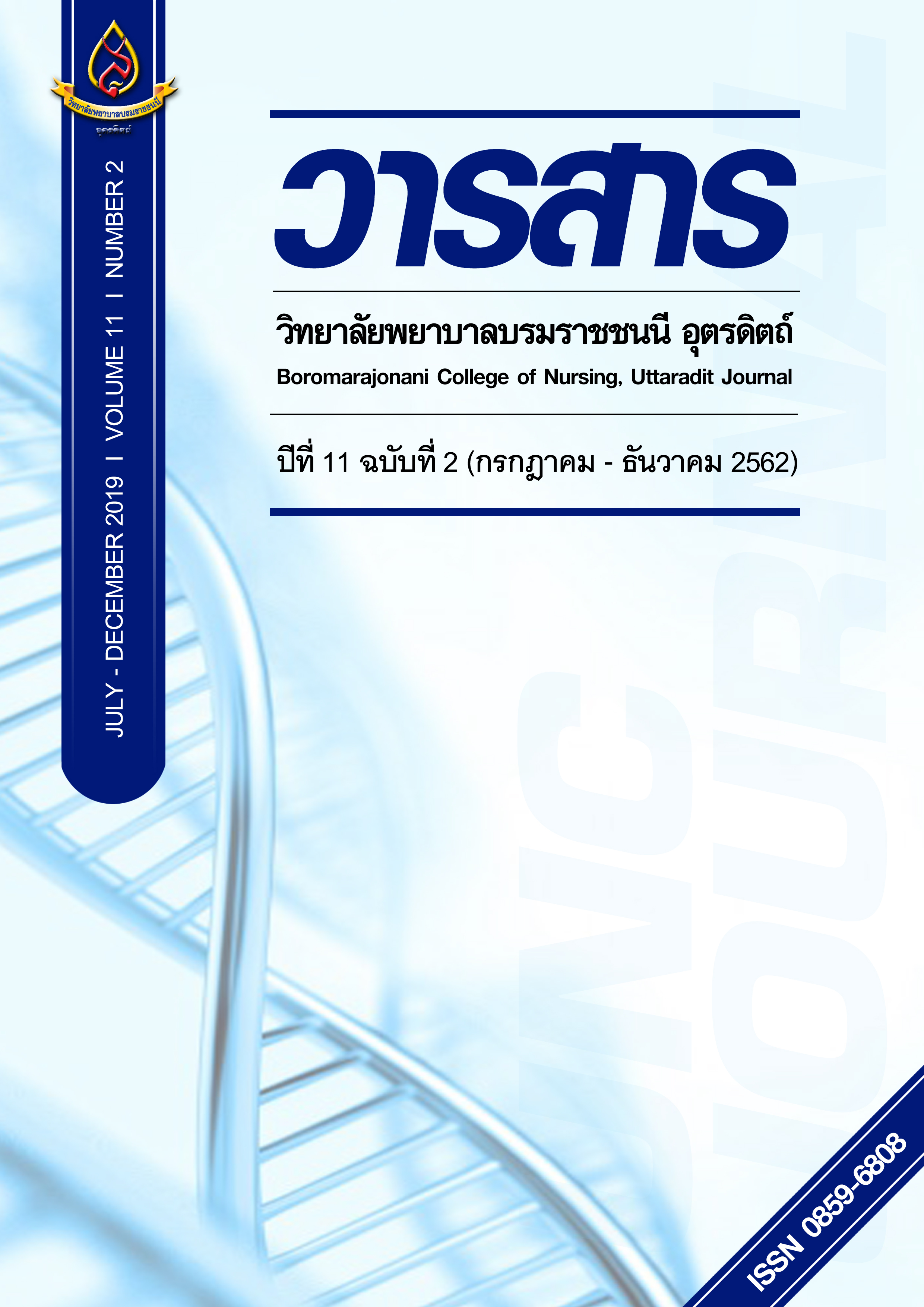การจัดการความปวดแบบผสมผสาน: การตั้งเป้าหมายระดับความปวดหลังผ่าตัด
Main Article Content
บทคัดย่อ
บทความนี้ มุ่งเสนอแนวคิดเกี่ยวกับการจัดการความปวดแบบผสมผสานเพราะความปวดหลังผ่าตัดเป็นสิ่งที่ทำให้ผู้ป่วยเกิดความไม่สุขสบายและทุกข์ทรมาน ความปวดหลังผ่าตัดเคยถูกมองว่าเป็นสิ่งที่ต้องเกิดขึ้นแน่นอนและต้องอดทน แต่ปัจจุบันทัศนคติในเรื่องนี้ได้เปลี่ยนไปโดยมองว่าความปวดหลังผ่าตัดเป็นเรื่องจัดการได้และเป็นสิ่งที่ควรทำเพื่อให้ผู้ป่วยมีคุณภาพชีวิตที่ดี ป้องกันภาวะแทรกซ้อน และลดระยะเวลาของการนอนโรงพยาบาล วิธีการจัดการความปวดที่นิยมในปัจจุบันคือการจัดการความปวดแบบผสมผสานโดยใช้ยาควบคุมความปวดร่วมกันหลายชนิด รวมทั้งใช้วิธีการจัดการความปวดแบบไม่ใช้ยาอื่นๆร่วมด้วย เพื่อเสริมฤทธิ์การระงับปวด ลดปริมาณการใช้ยาและลดผลข้างเคียงของยา การตั้งเป้าหมายระดับความปวดหลังผ่าตัดจึงเป็นอีกแนวทางหนึ่งของการจัดการความปวด ซึ่งเป็นบทบาทอิสระที่พยาบาลเปิดโอกาสให้ผู้ป่วยมีส่วนร่วมวางแผนและมีพันธะสัญญาในการจัดการความปวดร่วมกัน โดยการตั้งเป้าหมายระดับความปวดหลังผ่าตัดเป็นสิ่งที่เกิดขึ้นในกระบวนการคิดที่ผู้ป่วยกำหนดขึ้น เพื่อช่วยให้สามารถนำความคิดของตนมาเป็นแนวทางในการปฏิบัติเพื่อลดอาการปวดให้อยู่ระดับที่ตนเองยอมรับได้และเกิดผลลัพธ์ดีหลังการผ่าตัด
Article Details
บทความหรือข้อคิดเห็นใดใดที่ปรากฏในวารสารวิจัยการพยาบาลและวิทยาศาสตร์สุขภาพ เป็นวรรณกรรมของผู้เขียน ซึ่งบรรณาธิการหรือสมาคมศิษย์เก่า ไม่จำเป็นต้องเห็นด้วย และบทความที่ได้รับการตีพิมพ์เผยแพร่ถือเป็นลิขสิทธิ์ของวารสารวิจัยการพยาบาลและวิทยาศาสตร์สุขภาพ
เอกสารอ้างอิง
2) Bakar, Z.A., Yun, L.M., Keow, N.S., & Li, T.H. (2014). Goal-setting learning principles. Journal of Education and Learning, 8(1), 41-50.
3) Chaingarm, S. (2009). A study of pain perception and pain management in persons with abdominal surgery. (Master’s thesis), Rangsit University, Bangkok. (in Thai)
4) Damrongrucktham,C., Kimpee, S., Toskukao, T., & Asdornwised, U. (2009). Effects of hand reflexology on level of pain in abdominal surgery patients. Journal of Nursing Science, 27 (2)Supplement, May-Aug, 49-58. (in Thai)
5) Dhamakawinwong, A. & Yaiyaung, P. (2012). Effects of meditaion therapy for reducing pain among hip or knee replacement patient, Phichit Hospital. Phichit Hospital Journal, 27(2), 20-29. (in Thai)
6) Goodcoach. (2012). Benefits of setting goals (Online). Retrieved (2016, November 10) from https://oknation.nationtv.tv/blog/goodcoach/2012/01/05/entry-1. (in Thai)
7) Hinkle, J., & Cheever, K. H. (2018). Brunner & Suddarth’s: Textbook of mediacl-surgical nursing. (14th). Philadelphia: Wolters Kluwer.
8) Ignatavicius, D. D., &Workmann, M. L. (2010). Medical-surgical nursing: Patient-centered collaborative care (volume 2) (6 th). St.louis: Elsevier Saunder.
9)Im-erb, P., Kongchoom, W., Rimsueb, K. & et al. (2013). Journal of The Ministry of Public Health, 23(3), 53-62. (in Thai)
10( International Association for the Study of Pain: IASP. (2017). The 2017 IASP global year against pain after surgery. Retrieved (2016, November 10) from https://www.iasp-pain.org/GlobalYear/AfterSurgery.
11) International Association for the study of pain: IASPTerminology: Pain Terms. Retrieved (2016, November 10) from https://www.iasp-pain.org/Education/Content.aspx?ItemNumber=1698#Pain.
12) Jaipakdee, K., Nateetanasombat, K., & Punthasee, P. (2016). The Effect of postoperative pain management program by using aromatherapy and music therapy in postoperative patients with open reduction internal fixation of leg. Charoenkrung pracharak Hospital Journal, 12(2), 54-68. (in Thai)
13) Johnson, J. E. (1999). Self-regulation theory and coping with physical illness. Research in Nursing and Health, 22, 435-448.
14) Kaada, B., & Torsteinb, O.(1989). Increase of plasma ß-endorphins in connective tissue massage. The Vascular System, 20, 487-489.
15) Kumar, K.H., & Elavarasi, P. (2016). Definition of pain and classification of pain disorders. Journal of Advanced Clinical & Research Insights, 3, 87-90.
16) Locke, E. A., & Latham, G. P. (2006).New directions in goal-setting theory. Current Directions in Psychological Science, 15(5), 265-268.
17) McGuire, H.B. (1992). Comprehensive and multidimensional assessment and measurement of pain. Journal of Pain and Symptom Management, 7, 312-319.
18) McGuire, L. L. (2010). Pain: The fifth vital sign. In D. D. Ignatavicius.& M. L. Workman (Eds.), Medical-surgical nursing: Patient-centered collaborative care (6th ed.) (p.35-61).St Louis: Saunders Elsevier.
19) Nawai, A., & Phongphanngam,S. (2019). Exploring the use and efficacy of complementary and alternative interventions for managing chronic pain in older adults: A systematic review. Boromrajonani College of Nursing, Uttaradit Journal, 11(1),1-25.(in Thai)
20) Paiboonworachart, S. (2015). Pain and pain assessment. Retrieved (2016, November 11) from https://www.med.cmu.ac.th/dept/anes/2012/images/Lecture2015/BasicPain.pdf (in Thai)
21) Pansup, J., Ua-Kit, N., & Tanktikosoom, P. (2018). The Effect of concrete information program combined with hand reflexology on post operative pain in urological patients. Journal of The Police Nurses, 10(1), 51-60. (in Thai)
22) Rao, M. (2006). Acute post operative pain. Indian Journal of Anaesthesia, 50(5), 340-344.
23) Reddi, D., Curran, N., & Stephens, R. (2013). An introduction to pain pathways and mechanisms. British Journal of Hospital Medicine, 74 (12),188.
24) Sawangchai, J. & Ngamkham, S. (2017). Postoperative pain in patients after abdominal surgery Sawanpracharak Hospital. Journal of Health Science Research,11, Supplement, July-December, 1-11. (in Thai)
25) Soonsawad, n. (2015). Setting Goals of life and work. Journal of information, 14(2), 21-36. (in Thai)
26) Sprouse-Blum, A.S. ,Smith, G., Sugai, D., & Parsa, F.D. (2010). Understanding endorphins and their importance in pain management. Hawai'i Medical Journal, 69(3), 70-71.
27) Sritan, S. (2017). Effect of foot reflexology massage with breathing exercise on levels of pain in postoperative abdominal surgery patients. Journal of The Police Nurses, 9(1), 37-46. (in Thai)
28) Utsahapanich, S., & Tudpinij, S. (2011). The effect of guided imagery on acute pain in post operative colorectal cancer patients. Journal of Nursing Science & Health, 34(4), 36-45. (in Thai)
29) Utsahapanich, S., &Tudpinij,S. (2011).The effect of guided imagery on acute pain in post operative colorectal cancer patients. Journal of Nursing Science & Health, 34(4), 36-45. (in Thai)


